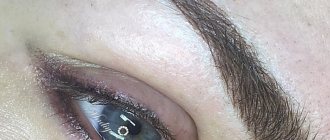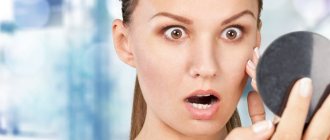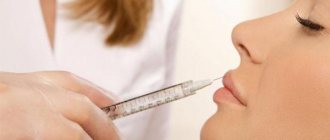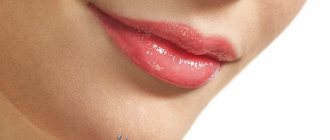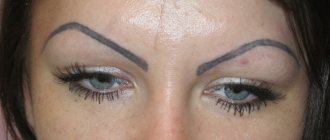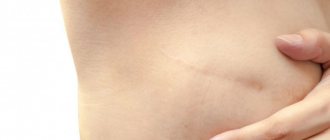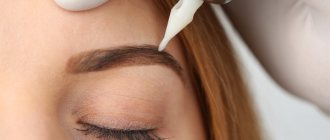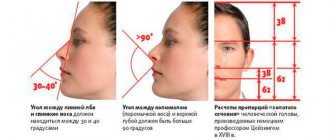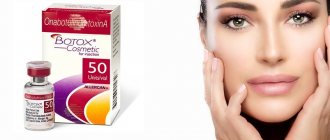Permanent makeup is one of the options for aesthetic correction of natural facial features. With its help, you can emphasize the contour of the eyes, change the shape and color of the lips, hide defects in eyebrow growth, and make the face more symmetrical. This procedure is a salvation for women suffering from allergies to decorative cosmetics and those who do not have enough time or skills to do high-quality makeup.
One of the most popular services in this area is eyebrow tattooing. If it is done in a salon by a certified specialist, health risks will be minimized. But like any procedure associated with skin damage, it has a number of contraindications.
When should you not tattoo your eyebrows?
Eyebrow tattooing is a long-term correction of the appearance of the eyebrow arch, achieved by introducing a coloring pigment under the skin. The effect lasts from 2 to 7 years. Since the procedure involves violating the integrity of the upper layers of the skin, it has a number of absolute and relative contraindications.
Contraindications:
| Absolute | Relative |
|
|
Eyebrow tattooing, the contraindications to which are relative, can be performed after they have been eliminated. However, there are people whose pigment does not take root, despite the absence of restrictions on the procedure.
There is still no clear explanation for this phenomenon, but doctors are inclined to believe that the cause of an unsatisfactory result may be a violation of metabolic processes in the layers of the epidermis. Such deviations have no external signs and are difficult to identify.
The post-effect of taking hormonal drugs or weakened immunity due to infectious diseases can affect the course of the procedure. If even after repeated correction the body rejects the pigment, but the client does not have any contraindications, he should consult a doctor.
Facial tattoo: what is it?
Tattooing is a procedure in which a design is applied to a selected part of the face using pigment. The drawing is also agreed upon with the cosmetologist, as is the color of the work before the start of the session.
The dye is used with a gentle composition to prevent the client from developing an allergic reaction to the dye. This is further accompanied by consequences based on such a parameter.
Facial tattooing is done on different areas depending on the desire or possibility of the woman who came to cosmetology:
- Lips. To avoid using decorative cosmetics in the lip area, a dye is applied to them. In this case, the motive for this may be: an unclear outline due to a congenital defect or age-related changes, a dull shade, or a desire to visually increase their size. Most masters will do a simple technique, but the 3D effect for visual enlargement requires certain skills, with the help of which smooth transitions of tones are made.
- Eyelids. Girls often use this technique to replace eye shadow or eyeliner, saving daily time spent on applying makeup. A common technique on the eyelids are winged eyeliners because they have advantages. Neatly designed arrows are suitable for any occasion, they make the look stricter and fresher, not all girls know how to draw them, so tattooing is the solution. You can also make a decorative technique or interlash liner, due to which the eyelashes visually become longer and darker, this opens up the look, which replaces the constant use of mascara.
- Brows. This part of the face is most often used for tattooing because eyebrows are a fundamental part of the face. It often creates an overall appearance, so you need to be careful with it. To get neat, natural eyebrows, you should spend time choosing a cosmetologist, this will help you get natural eyebrows. There are two methods: shading and hair method. In the second method, small hairs are drawn pointwise, the completed drawing looks impressive.
The service requires attention from women, since the result depends on three factors:
- The correct selection of a specialist in facial tattooing and cosmetology. This also includes the quality of the materials used.
- The preparation provided to the face before the dye is introduced, its subtleties are explained by the cosmetologist.
- Care during the rehabilitation period of the skin. The face heals within a month, then the initial correction takes place.
If you trust a specialist, you should follow his instructions and instructions in order to ultimately get a natural result. Do not neglect contraindications, as this will lead to side effects in the form of a change in the type of work and a deterioration in the client’s health.
Absolute contraindications
Absolute contraindications are those that completely exclude the possibility of carrying out the procedure, because it can have a negative effect on the body or lead to a deterioration in health.
Blood problems
Eyebrow tauage, contraindications to which may be associated with disruption of the hematopoietic system, is contraindicated for people with poor clotting ability.
Penetration of the instrument under the skin may be accompanied by damage to small blood vessels and bleeding, which seriously complicates the work of the master. Part of the pigment is washed away with the blood, which significantly reduces the effectiveness of the procedure.
Acute phases of diseases
The exacerbation of any infectious diseases is accompanied by a sharp decrease in the body's resistance to various infections. In order not to expose yourself to the risk of infection, it is better to cancel the procedure and book again after full recovery.
Kidney and liver failure
The liver and kidneys are responsible for removing toxins from the body.
If the functioning of these organs is disrupted, allergic reactions to the pigment or the medications used may occur.
Hepatitis
Hepatitis is an inflammatory liver disease of viral origin, included in the list of absolute contraindications. Today, its influence on the result of the procedure has been reviewed and tattooing is allowed, but only on the condition that it is not in the acute phase. If liver cirrhosis has developed as a result of hepatitis, the procedure is strictly prohibited.
Autoimmune failure
Autoimmune diseases are a malfunction of the immune system when it begins to perceive healthy cells in the body as damaged and attacks them with antibodies. Disruption of the immune mechanism has a detrimental effect on skin regeneration and pigmentation.
With this pathology, the body can reject the pigment and provoke allergic reactions and secondary infections. If there is an urgent need to get a tattoo, you must first undergo tests for the level of hormones and antibodies and obtain permission for the procedure from the attending physician.
Diabetes
Diabetes mellitus is an endocrine disease accompanied by metabolic disorders and damage to large and small blood vessels. Diabetics are at high risk of bleeding even from minor injuries. Healing of the dermis occurs slowly.
Reduced immunity can cause the development of infectious diseases. In addition, pain can trigger a sharp drop in blood sugar levels and the onset of a hypoglycemic coma. Most artists who do not have a medical education refuse to tattoo insulin-dependent clients because they do not want to be responsible for the possible consequences.
Tendency to keloid scars
Eyebrow tattooing, contraindications to which may be due to a predisposition to the formation of keloid scars, is not recommended for women over 40 years of age.
In adulthood, skin cell regeneration slows down, and any damage to the skin can be accompanied by the formation of rough scars. Keloid scars are characterized by the fact that they spread beyond the tissue damage, expanding the area of deformation of the skin. Such defects are difficult to correct even with the help of cosmetic procedures.
Oncological diseases
Oncological diseases are an absolute contraindication to tattooing. Chemotherapy exposes the body to serious stress, regenerative processes are slowed down, and even the slightest damage to the skin can cause increased growth of a malignant tumor.
There are exceptional cases when, at the stage of remission, doctors can allow the patient to undergo a cosmetic procedure. However, if skin cancer is diagnosed, permanent makeup is prohibited, even after complete recovery.
HIV AIDS
Most contraindications to the application of permanent makeup are associated with a decrease in the body's resistance to external and internal infections. This is why tattooing is strictly not recommended if you have the immunodeficiency virus or AIDS.
There is an opinion that masters refuse services to infected people because they are afraid of becoming infected. However, it is not.
There is a rule according to which salon specialists regard each client as potentially infected and take all necessary precautions to protect themselves.
But this does not guarantee that the instruments used by the master are absolutely sterile. During the procedure, a person experiences stress, which further reduces immune defense, so any secondary infection can be fatal.
Pregnancy and lactation
During pregnancy and lactation, hormonal changes occur in the female body that affect the skin's perception of coloring pigment. This contraindication can be considered relative rather than absolute, but doctors recommend refraining from permanent tattooing until you stop breastfeeding completely.
Injuries
On scars left after injuries, the coloring pigment is less easily fixed. To achieve a sustainable result, several corrective procedures are necessary.
Rashes, skin inflammations
Acne, ulcers, dryness, peeling and inflammation of the skin are indicators of the presence of infections in the body. During the procedure, it can easily enter the blood through damaged capillaries and cause infection. Therefore, before making an appointment for a tattoo, it is necessary to eliminate the cause of skin problems and eliminate it.
How to care for permanent makeup
Are you going to get your eyebrows tattooed or have you already done it, but don’t know how to care for them? Then this article is for you. We have collected tips for you that will help you avoid scars, swelling, and dye bleeding after the procedure. After all, a lot depends on proper care, as well as on the right specialist.
Why do we resort to permanent eyebrow makeup? Because we always want to look irresistible. After all, eyebrows give our image even more attractive. Therefore, it is very important to choose the right form and then maintain it.
I also really want to save time in the morning and not waste it on eyebrow makeup. After all, sometimes it’s possible to quickly draw a contour and make the desired bend, and sometimes it takes a lot of time. Therefore, microblading or tattooing is our salvation!
For those who have not yet decided and are just collecting information, I suggest listening to real reviews about the permanent makeup procedure and its results. Since I only did arrow tattoos, I’ll leave my review when we talk about them)))
We warn you that you only need to contact a professional craftsman who will take into account all your wishes and will be very careful in his work. And we, in turn, advise you to use this information as a cheat sheet so that permanent makeup will serve you for a long time!
Immediately after the procedure, your eyebrows will be quite bright and their contour will be clear. This may scare you a little, since not every woman dares to go out with such bright makeup.
Do not worry! It should take some time to heal and the pigment will fade over time, leaving you with a nice, natural shade. Let's figure out how makeup heals day by day, and then we'll tell you what not to do after the procedure.
So, you have decided to get a tattoo. We have chosen a good salon, they have chosen a beautiful shape for you, the necessary shade that is in harmony with your appearance and hair color. You left the salon. How will the makeup heal?
Healing stages:
- Day 1−2. They are similar to each other, since the eyebrows have very bright outlines, as if they had just been drawn with a pencil or felt-tip pen.
- Day 3 - 4. Crusts are forming. They cannot be deleted! Otherwise, you may remove some of the pigment and have to redo the whole job. Be patient just a little. The crusts will come off soon.
During this period, we advise you to apply Bepanten or D-panthenol . They relieve tightness. Avoid dryness and discomfort. Treat skin every 2-3 hours.
- Day 5 - 6. The crusts will begin to disappear, the pain will subside and the pigment will begin to lighten. But after a while the brightness will return, but the shade will no longer be so saturated.
- Day 7−8. The crusts have already completely disappeared. You may be upset by the fact that the pigment is almost invisible. But don't worry! After two days, the brightness will finally return. This will be the final version of the procedure. If you still lack color, then the specialist can add a little dye during correction.
Result before and after
How your eyebrows will look in the future depends on proper care. This is a very important stage. Do not neglect it, otherwise the master’s labors will not be crowned with success, and you will be full of disappointment.
Follow these tips and you will prolong the amazing results of permanent makeup for a long time.
Immediately after the procedure and for the next 2 weeks it is prohibited:
- Refrain from visiting the sauna (bath), swimming pool, solarium, do not dive into the sea. Various infections can occur with water. After all, there are still unhealed wounds on the skin now.
- After washing, gently pat your face dry with a towel. Try not to get your eyebrows too wet.
- Do not apply masks, scrubs, or peelings to the skin after permanent treatment. It is better to give up cosmetics for a while.
- It is not recommended to wet your eyebrows for the first 2 days. Therefore, wash your hair before the procedure.
- If ichor appears, it should be slightly blotted. And treat the skin with ointment, chlorhexidine or miramistin.
- Try not to touch the skin with your hands, scratch your eyebrows or touch the scabs!
Agree, the recommendations are simple and easy to follow.
The most important thing is not to touch the crusts and at this moment moisturize the skin as much as possible. Otherwise, it can lead to the appearance of scars, scars and swelling. It can also easily become infected. Take care of yourself and your health, follow all care instructions!
Surely you are concerned about the question: “How long does permanent makeup last?” Now we will answer it. But remember, how long it will decorate your face depends on you, or rather on how carefully you took care of your makeup after the procedure.
- The brighter and more intense the permanent makeup is, the longer it will last.
- Individual characteristics of the body.
- Skin renewal. A young woman renews herself faster than a mature one, and accordingly, the tattoo comes off faster.
- The pigment lasts longer on the eyelids than on the eyebrows and lips. Take this into account.
- Moisturizing your skin is essential if you want to make your makeup last longer.
- Sunlight causes the dye to fade.
Over time, the pigment comes out of the deep layers of the skin and is washed away. This happens not only with makeup, but even with a regular tattoo. To avoid complete “washing out” of the dye, you can make a correction. We will talk about this in more detail in the next article.
Relative contraindications
Relative contraindications are those that allow the procedure to be carried out after eliminating the reasons why it cannot be recommended at the moment.
Period
During menstruation, the psycho-emotional state and hormonal levels change. A procedure that previously did not cause discomfort can be very painful in the first days of the cycle.
When getting tattooed during menstruation, you may encounter the following complications:
- decreased effectiveness of anesthesia;
- increased sensitivity of the skin to puncture;
- slow regeneration:
- pigment rejection.
In order for the procedure to give the expected result, it is recommended to carry it out a few days after the end of menstruation.
Age
Permanent makeup is contraindicated for children under the age of majority. The pigments used can cause harm to a fragile body. Tattooing is indicated only for the correction of congenital or injury-related defects. Some cosmetologists agree to perform the procedure, but only after the written consent of the teenager’s parents.
Blood pressure disorders
Applying permanent makeup is considered stressful for the body. Carrying out the procedure with high blood pressure (BP) can cause a hypertensive crisis. If there is a predisposition to blood pressure surges, it is recommended to measure it before the start of the session. If the readings are higher than normal, you need to take an antihypertensive drug or reschedule the procedure for another time.
For hypotensive patients with a tendency to lose consciousness, it is necessary to select gentle methods of tattooing. If there are disturbances in the functioning of the cardiovascular or respiratory system, the procedure should be carried out in a position with the head raised. This reduces blood flow to the head and helps avoid severe swelling.
Allergy
Some tattooing methods are quite painful, so local anesthesia is required. If the client is allergic to certain anesthetics, he must inform the specialist in advance so that he can select another drug.
An allergic reaction to novocaine and lidocaine can cause hives and swelling. This is especially dangerous when correcting the shape and color of the lips.
Viral infections
During viral diseases accompanied by fever, the procedure is strictly not recommended. In the best case, the pigment simply will not be fixed and there will be no effect, and in the worst case, an exacerbation of the herpetic infection may be provoked.
Recent surgeries and serious illnesses
Surgical interventions under general anesthesia are a serious stress for the body, which greatly suppresses the human immune system. You cannot do permanent makeup immediately after surgery. This rule applies not only to health care, but also to plastic surgery. For example, after blepharoplasty, eyebrow tattooing is allowed no earlier than six months later.
Undergoing drug treatment
Permanent makeup is not recommended during course therapy.
The following complications are possible when taking hormonal drugs:
- risk of infection due to drug-induced immunosuppression;
- increased skin sensitivity to ultraviolet radiation;
- decreased rate of skin cell regeneration;
- the possibility of changing the body's response to the drug.
Taking non-steroidal anti-inflammatory drugs, as well as anticoagulants, can lead to prolonged bleeding and complications during wound healing. Some psychotropic substances can cause inflammation of blood vessels and necrosis of the skin.
If you are undergoing long-term drug treatment, you must consult your doctor before scheduling a tattoo.
Herpes in the acute stage
Herpetic rashes occur not only on the lips. There is ocular herpes, one of the manifestations of which is watery blisters in the area of the eyelids and eyebrows. During the acute stage of the disease, permanent makeup is strictly prohibited.
During the procedure, the coloring pigment is injected under the skin to a depth of 2-3 mm, but it is not fixed at the site of the rash, so several repeated corrections have to be made to even out the color and shape.
Conjunctivitis
Conjunctivitis is an inflammation of the mucous membrane of the eye caused by an allergic reaction or an infectious disease. In fact, this disease can only become an obstacle to tattooing the upper eyelid. However, if you regard it as an indicator of the presence of an infection in the body that affects the state of immunity, it is better to first consult with an ophthalmologist.
Benign neoplasms
Eyebrow tattooing is also contraindicated in the presence of benign neoplasms. The presence of papillomas, moles or warts in the correction area makes the procedure impossible, since their surface cannot be injured.
Any damage can lead to an increase in the size of the tumors and the appearance of new rashes. Permanent makeup can be done only after the formations have been removed and the skin surface has completely healed.
Alcohol or drug intoxication
The ban on performing the procedure for clients under the influence of alcohol or drugs is due to the following factors:
- Increased blood pressure provokes the release of blood droplets in the correction area, preventing the specialist from drawing out the contour. It is possible that the pigment will be completely or partially rejected, as a result of which the tattoo area will be filled unevenly;
Eyebrow tattooing can be done after drinking a little! - the remaining alcohol, reacting with the dye, can affect its color. It is possible that instead of black eyebrows the client will receive green ones;
- poisoning with toxic substances increases the risk of a negative reaction of the body to the drugs used by the master;
- alcohol has an unpredictable effect on a person's perception of anesthetics. It can either strengthen their effect or weaken it.
Besides, working with a person breathing fumes, to say the least.
Poor health of any origin
Unsatisfactory health can be expressed in the following manifestations:
- drowsiness and fatigue;
- dizziness and pain;
- constant feeling of irritation;
- increased fatigue.
All these are obvious signs of weakened immunity. In this condition, the risk of complications increases, tissue healing occurs much more slowly. If you feel unwell, it is recommended to reschedule the procedure to another day.
Permanent makeup technique
The first session begins with a discussion of future work. It clarifies important aspects: the color scheme of the design, the style of tattooing, the features of the individual epidermis and the client’s wishes.
Also at this visit, a test is done to determine if there is an allergic reaction to the pigment used in the work; testing is carried out as standard on the girl’s wrist.
The specialist also writes out instructions to the client that he must follow before the main visit; an appointment is made for the next day. Preparation usually requires the following:
- Do not carry out cosmetic procedures on the facial area for tattooing a month in advance (if there is aggressive intervention in the epidermis).
- Do not drink alcohol, energy drinks, or coffee the day before your visit.
- If tattooing is performed on eyebrows, you do not need to pluck them, remove excess hair, or paint them with aggressive paints for two weeks. Also, give up decorative cosmetics in the selected area two days in advance.
- Do not plan a vacation after tattooing; provide a week of complete rest for the skin so that it can rehabilitate after the intervention.
The client is also given a list of contraindications with which he must compare his health status. Restrictions should not be neglected, as they lead to negative consequences after tattooing.
At the beginning of the main visit, a mock-up is drawn on the face, which is corrected if necessary, and then approved by both parties involved in the provision of the service.
All cosmetics are washed off the girl’s face, including foundation, which retouches the surface of the skin. This is done using a cotton pad soaked in micellar water.
Anesthesia is applied in the form of a gel. The anesthetic is designed in this way so as not to further damage the epidermis with the injection. Its action begins after 15 or 20 minutes, depending on the chosen product.
The artist operates a special tattoo machine, at the end of which there is a needle through which the dye is injected. It is individual, so it must be opened in front of the client.
The dye is usually injected within two hours. The maximum time during which a session is safe is three hours. If the work lasts longer, it is divided into two or three doses so as not to overload the epidermis of the face.
At the end, the specialist gives the woman instructions, which indicate the care that she should provide for the damaged skin during its recovery.
Bad time for the procedure
Eyebrow tattooing, contraindications to which, in most cases, are justified by health problems, is not recommended to be done in the summer.
There are several reasons for this recommendation:
- high air temperature promotes active sweating, which complicates tissue healing after the procedure;
- swimming in open water afterwards can cause infection;
- dusty air, saturated with pollen from flowering plants, is a direct source of infection.
It is also not recommended to carry out the procedure in winter. Icy wind, snow and prickly rain cause peeling of the skin, which can reduce the efforts of the specialist to zero. The best time for tattooing is considered to be the beginning of autumn. Comfortable air temperature, a vitamin-rich body and a strong immune system are the guarantees of a good result.
How to perform eyebrow tattooing using watercolor technique
Often girls and women who are going to undergo a procedure using the watercolor technique of eyebrow tattooing ask how long does the result last? However, there are many other nuances that are important to know about. For such a service, it is recommended to contact a beauty salon and select a specialist in advance based on reviews and photographs of the work. A cosmetologist must have good artistic taste, extensive experience, and be fluent in technique. Such a master must be not only an artist, but also a psychologist, have an understanding of the rules of photography, and have the necessary knowledge in the medical field.
First of all, the cosmetologist discusses the thickness and shape of your eyebrows with you and takes into account all your wishes. Next, temporary contours are made to simplify the application of pigment using watercolor technique. After this, the watercolor tattoo itself is performed under anesthesia, injecting the dye under the skin with a sterile thin needle. The whole work takes one and a half to three hours. After three weeks, it is better to repeat the procedure, since this way it is possible to consolidate the effect obtained.
Possible health consequences after eyebrow tattooing
Negative health consequences after eyebrow tattooing are possible in two cases:
- ignorance or deliberate concealment of the presence of contraindications;
- unprofessionalism of the tattoo artist.
Both options are fraught with the occurrence of allergic reactions, the risk of a herpes outbreak, infection with viral or infectious diseases, and problems with healing of the treated area.
This can only be avoided if you responsibly choose a specialist and place for the procedure and honestly answer all questions about your health before the session begins.
Eyebrow tattooing is not the easiest procedure, which has many contraindications, and it is better to do it in cosmetic or tattoo parlors from certified artists. When choosing, it is recommended to rely on the establishment’s rating, customer reviews and examples of completed work.
Article design: Vladimir the Great
How does watercolor technique differ from other types of tattooing?
Today, the beauty industry can offer a large selection of types of tattooing. Permanent makeup techniques differ in the method and depth of pigment application, the appearance of the final result, the characteristics of care and the period during which the effect lasts. Experts highlight:
1. Hair tattoo.
This technique is used if it is necessary to achieve the most natural appearance of the eyebrows. The master works with a thin blade on the device to draw stripes on the skin that imitate hairs. This method allows you to change the shape and length of the eyebrows, smooth out existing imperfections, and make the face more symmetrical.
This option is right for you if:
- The eyebrows are not thick enough and require additional coloring every day.
- By nature, eyebrows have different shapes, and the situation cannot be corrected by removing hairs and styling with special products.
- You are not satisfied with the shape of your eyebrows, so you need to increase the width or length, give them a sharper or, conversely, smoother bend.
There are two varieties of this permanent makeup technique: European and Eastern. The first is considered simpler, as it requires little time, effort and materials. In this case, the drawn hairs are the same size and located in the same direction. This kind of work is inexpensive.
The eastern technique is not so simple, as it involves depicting hair growing in three different directions. It is this approach that allows you to achieve the most natural appearance. If the client has individual characteristics, the cosmetologist copies them during the work process. This procedure requires much more time and a high level of specialist skill, and therefore costs more.
Recovery after using the hair tattoo technique is quite quick because the dye does not penetrate into the deep layers of the skin. In addition, you need to understand that in this case the minimum amount of pigment required to color the hairs is used.
2. Powder spraying.
Just by the name of the technique, its principle becomes clear. The method described above involved the image of eyebrows, as if drawn with a sharp pencil. Here, the entire area is covered with pigment, creating smooth transitions, and the result is most similar to makeup with shadows. This tattoo technique also has a number of subtypes.
Powder spraying involves applying the permanent to a shallow depth, that is, only the outer layers of the epidermis are affected. This feature of the technique allows you to quickly complete the recovery process, but will also require more frequent corrections compared to other procedures. The master does not paint the entire plane, but applies the permanent in small dots, thereby creating a more realistic effect.
After the recovery period is complete, the hair becomes matte, making it less greasy. This tattooing technique allows you to achieve the effect of applying cosmetic powder.
3. Pixel spraying.
When using this technique, the master introduces a minimal amount of pigment under the skin. For this purpose, a special device is used that allows for dot tattooing. This technique creates a clear and bright contour, so it will not be possible to achieve the effect of natural hair. Eyebrows look as if they have been slightly tinted with pencil or eye shadow.
In addition, it will not be possible to change the appearance and shape of the eyebrows using this technique, since individual hairs are not drawn here, but the entire area of the eyebrow is painted over with small dots. The name of the technique is explained by the fact that such dots are similar to pixels. Since the spraying method is used for painting, there is not much pigment under the skin, in the upper layers of the epidermis. This leads to the dye quickly losing color, and correction has to be made. You will need to come back for a follow-up appointment with the cosmetologist after the restoration is complete so that the specialist can set a date for correction.
4. Shadow technique.
This technique is most popular among fans of natural beauty. Today, cosmetologists most often offer two types of such permanent makeup:
- Spraying, in which the gaps between already growing hairs are painted over. Thanks to the resulting background, the hair appears thicker and the eyebrows have clearer contours. It is important to choose the shade of the pigment so that it matches the tone of the hairs, otherwise the result will look ridiculous.
- Shadow painting. The difference between spraying and this technique is that it uses drawing with borders and endings. In this way, it is possible to darken the necessary places; for example, the tail is most often painted in a tone slightly darker than the main color.
For the shadow technique, natural shades of dye are used, as close as possible to the natural tone. Recovery after the procedure does not require much time, and the result continues to please the owner throughout the year. If you don't want to correct or intensify the color, you can enjoy the light shade for about two more years.
5. Watercolor technique.
Not all salons offer the watercolor technique of eyebrow tattooing. During this procedure, the master applies pigment using a machine, forming beautiful and most natural transitions. If a girl has too thin or short eyebrows, this technique will not increase their thickness or length.
Many people ask about the watercolor technique for eyebrow tattooing. What is this? It differs from many others in that with this design, no boundaries are drawn, painting only the inner space of the eyebrow. As a result, it is possible to achieve the most natural effect.
The dye is sprayed onto the skin and hairs, so it does not penetrate into the deep layers of the epidermis. If we compare the watercolor tattoo technique with all the others, in this case the pigment penetrates the skin the least. In this case, there is no sudden discoloration of the makeup, and the result lasts for at least three years. According to experts, following the rules of care allows you to maintain the resulting effect for an even longer period.
Recommended reading:
- What not to do after eyelash extensions
- Which eyelash extension to choose for yourself
- Eyelash care: advice from professionals
You need to understand that not every master can provide such a service, because it requires special skills. To do this, you need to take art courses for cosmetologists. There, masters learn to select and evaluate shades of colors, based on the appearance characteristics of a particular client, and also create smooth transitions characteristic of this technique.
Lip tattoo
No less common nowadays is permanent lip makeup. It is based both on outlining the contour of the lips and on shading the rest of their surface. The lip tattoo procedure consists of several main stages. Initially, a basting outline is applied, and then the final one. If the client wishes, another stage is performed - shading. This makes lips look more natural and vibrant. When applying permanent makeup, lips usually swell. The final result of tattooing can be appreciated only five to six hours after the procedure.
How long does it take for eyebrows to heal after tattooing?
If there are no complications, then, as the girls’ reviews indicate, the eyebrows will look healthy and well-groomed in just 10 days.
But for the first time after the session, a feeling of discomfort will be felt. This is due to the fact that permanent makeup, although not a surgical intervention, still violates the surface layer of the skin. This means that various unpleasant consequences are possible.
The first day after the session, the wound may bleed. In this case, the area can be carefully treated with chlohexidine. To do this, a cotton wool soaked in the solution must be lightly applied to the eyebrows. The area should be treated every two hours. When doing this, you should be careful not to injure the skin or cause swelling or bruising. In this case, recovery will take longer.
Next, the skin is treated with chlorhexidine once a day. After drying, the eyebrows are smeared with a nourishing cream. Its remains must be removed after 10 minutes. Such procedures are carried out until the crust on the eyebrows is completely removed. By its thickness you can understand how long the tattoo will take to heal: thin indicates rapid healing, if thick, it will take longer to recover.
You cannot remove the crust yourself. This can lead not only to infection, but also to the removal of pigment. The color of the eyebrows in this place will be different.
Reviews from girls say that eyebrows heal completely within a month. Eyebrows will acquire the correct natural shape. But even after this, you should still take precautions for some time, since the skin after tattooing is very sensitive. Due to improper care, cracks and bruises may form on it.
How to choose a specialist who can do eyebrow tattooing using watercolor technique
If you want to look good, you should not only have a trusted dentist and hairdresser, but also a tattoo artist. After all, working with a true professional will allow you not only to highlight your beauty, but also to follow the latest fashion trends. It's no secret that the shapes of eyebrows and lips are also subject to trends and may lose their relevance. But a real master will emphasize your natural beauty and highlight your strengths using the right technique.
Of course, you can go to a home-based hairdresser or visit the nearest hairdresser, but then there is a high probability that you will be faced with the cheapest equipment and non-compliance with sanitary standards. Therefore, if you want a really high-quality tattoo using watercolor techniques, it is better to go to professionals. Otherwise, you are at great risk.
The consequences of tattooing and how to get rid of them
Complications that arise may delay the healing process of eyebrows after applying permanent makeup. In this case, it is necessary to eliminate the unpleasant consequences:
- Swelling may occur during the session. This is due to the body's reaction to the dye or anesthetic. In this case, it is necessary to start taking antiallergic drugs.
- If you feel pain, you can take a painkiller. However, most often girls with a low pain threshold feel pain after the session.
- During the tattooing process, a bruise may form. This occurs as a result of improper selection of anesthesia, fragile blood vessels or stagnation of blood in the eyebrow area. If you know about this feature of your body, you should take a course of medications in advance to reduce the risk of hematomas.
In order to avoid bruising, you should not tattoo a few days before, during and after menstruation. At this time, the body lacks zinc, and this is a direct path to the appearance of bruises.
After eliminating complications, the skin healing process will go faster.
